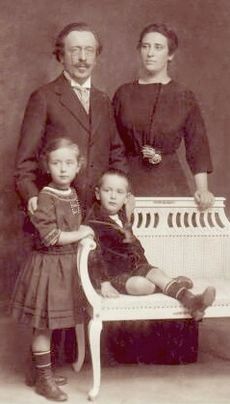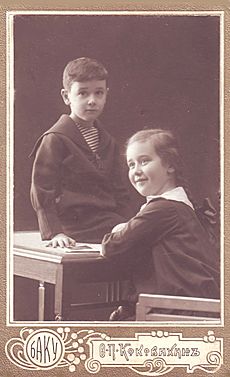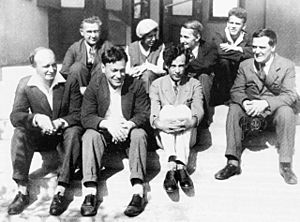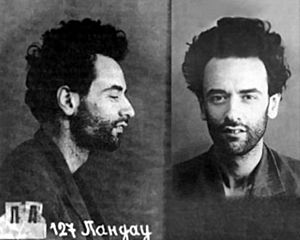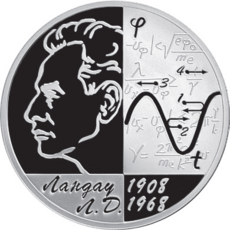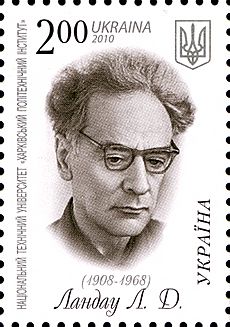Lev Landau facts for kids
Quick facts for kids
Lev Landau
|
|
|---|---|
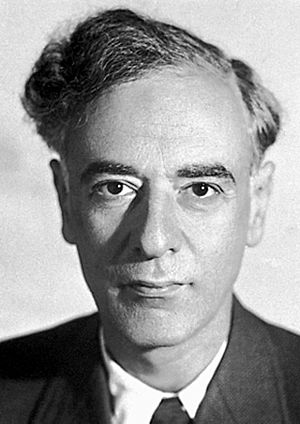
Landau in 1962
|
|
| Born |
Lev Davidovich Landau
22 January 1908 |
| Died | 1 April 1968 (aged 60) |
| Resting place | Novodevichy Cemetery, Moscow |
| Citizenship | Russian Empire Soviet Union Azerbaijan Democratic Republic |
| Education | Baku Economical Technical School |
| Alma mater | Baku State University Leningrad State University (diploma, 1927) Leningrad Physico-Technical Institute (D.Sc., 1934) |
| Known for |
List
Landau damping
Landau distribution Landau gauge Landau pole Landau susceptibility Landau free energy Landau quantization Landau's Fermi liquid theory Landau's phase transition theory Landau–Squire jet Landau–Levich problem Stuart–Landau equation Ginzburg–Landau theory Darrieus–Landau instability Landau kinetic equation Landau singularities Landau–Raychaudhuri equation Landau–Zener formula Landau–Pekar equations Landau–Teller model Landau–Lifshitz fluctuating hydrodynamics Landau–Lifshitz model Landau–Lifshitz pseudotensor Landau–Lifshitz–Gilbert equation Landau–Pomeranchuk–Migdal effect Guderley–Landau–Stanyukovich problem Landau–Placzek ratio Landau–Yang theorem Ivanenko–Landau–Kähler equation Landau principle Landau–Hopf theory of turbulence Density matrix DLVO theory Open quantum system Polaron Roton Superfluidity Superconductivity Course of Theoretical Physics Quantum hydrodynamics Quasiparticle theory Zero sound Antiferromagnetism |
| Spouse(s) | K. T. Drobanzeva (married 1937; 1 child) (1908–1984) |
| Awards | Stalin Prize (1946) Max Planck Medal (1960) Fritz London Memorial Prize (1960) Nobel Prize in Physics (1962) |
| Scientific career | |
| Fields | Theoretical physics |
| Institutions | Kharkiv Polytechnic Institute and Kharkiv University (later Kharkiv Institute of Physics and Technology) Institute for Physical Problems (RAS) MSU Faculty of Physics |
| Academic advisors | Niels Bohr |
| Doctoral students | Alexei Alexeyevich Abrikosov Aleksandr Ilyich Akhiezer Igor Ekhielevich Dzyaloshinskii Lev Gor'kov Isaak Markovich Khalatnikov Lev Petrovich Pitaevskii |
| Other notable students | Evgeny Lifshitz |
Lev Davidovich Landau (born January 22, 1908 – died April 1, 1968) was a brilliant Soviet physicist. He made many important discoveries in theoretical physics, which is the study of physics using math and models instead of experiments.
Landau is famous for his work on superfluidity, which explains how some liquids can flow without any friction. He also helped develop the Ginzburg–Landau theory of superconductivity, where materials can conduct electricity perfectly. For his amazing work on superfluidity, especially how it explains the behavior of liquid helium at very cold temperatures, he won the 1962 Nobel Prize in Physics.
Contents
Life Story of a Genius
Early Years and Education
Lev Landau was born on January 22, 1908, in Baku, which was part of the Russian Empire and is now Azerbaijan. His father, David Lvovich Landau, was an engineer in the oil industry. His mother, Lyubov Veniaminovna Garkavi-Landau, was a doctor.
Lev was very smart from a young age. He learned differential calculus (a type of advanced math) when he was 12 and integral calculus when he was 13. He finished high school at age 13 in 1920. His parents thought he was too young for university, so he spent a year at a technical school.
In 1922, at just 14 years old, he started studying at Baku State University. He studied both physics and math, and also chemistry. He later focused only on physics and math, but he kept an interest in chemistry throughout his life.
Studying in Leningrad and Europe
In 1924, Landau moved to Leningrad State University (now Saint Petersburg State University), which was a major center for physics in the Soviet Union. He focused on theoretical physics and graduated in 1927. He then continued his studies at the Ioffe Physico-Technical Institute, where he earned his doctorate in 1934.
Between 1929 and 1931, Landau had the chance to travel abroad. He visited famous physics centers in Europe. A very important visit was to Copenhagen, Denmark, where he worked with the famous physicist Niels Bohr. Landau always looked up to Bohr and was greatly influenced by his ideas about physics. He also visited other places like Cambridge (England) and Zurich (Switzerland), working with other great scientists like Paul Dirac and Wolfgang Pauli.
Teaching and Research in Kharkiv
From 1932 to 1937, Landau led the theoretical physics department at the Kharkiv Institute of Physics and Technology in Ukraine. He also taught at the University of Kharkiv. In Kharkiv, Landau helped create a strong tradition of theoretical physics, often called the "Landau school."
During this time, he and his friend and former student, Evgeny Lifshitz, started writing a series of books called Course of Theoretical Physics. These ten books cover almost all areas of theoretical physics and are still used by university students today.
Landau also created a special test called the "Theoretical Minimum." Students had to pass this very difficult exam to join his school. Between 1934 and 1961, only 43 people passed it, but those who did became very important theoretical physicists.
Work in Moscow
In 1937, Landau moved to Moscow to lead the Theoretical Division at the Institute for Physical Problems.
In 1938, Landau faced a difficult time and was arrested for political reasons. He was held in prison for about a year. He was released thanks to the efforts of Pyotr Kapitsa, a well-known experimental physicist and the head of the institute. Kapitsa wrote directly to Joseph Stalin and even threatened to quit if Landau wasn't freed. After his release, Landau continued his groundbreaking work, including explaining Kapitsa's discovery of superfluidity using sound waves.
Landau also played a role in the Soviet Union's atomic and hydrogen bomb projects. He did important calculations for these projects. For his contributions, he received the Stalin Prize twice and was given the title "Hero of Socialist Labour" in 1954.
Many of Landau's students became famous physicists themselves, including Lev Pitaevskii, Alexei Abrikosov, and Isaak Khalatnikov.
Major Discoveries and Awards
Landau made many important contributions to physics. He helped develop the density matrix method in quantum mechanics and explained diamagnetism (how some materials react to magnetic fields). He also developed the theory of superfluidity and the theory of second-order phase transitions, which describe how materials change from one state to another.
His work also included the Ginzburg–Landau theory of superconductivity, the theory of Fermi liquids, and explaining Landau damping in plasma physics. He also worked on the Landau pole in quantum electrodynamics and the two-component theory of neutrinos.
In 1962, Landau received the Nobel Prize in Physics for his mathematical theory of superfluidity. This theory helped explain the strange properties of liquid helium when it's cooled to extremely low temperatures, below -270 degrees Celsius.
Personal Life and Later Years
In 1937, Landau married Kora T. Drobanzeva. Their son, Igor, also became a theoretical physicist.
On January 7, 1962, Landau was in a serious car accident. He was badly injured and was in a coma for two months. Even though he recovered in many ways, his ability to do scientific work was sadly affected. Because of his injuries, he couldn't go to Sweden to accept his 1962 Nobel Prize in person.
Landau was known for his sharp sense of humor. Once, while recovering from the accident, a psychologist asked him to draw a circle. Landau drew a cross. Then the psychologist asked him to draw a cross, and Landau drew a circle. When asked why he didn't follow instructions, Landau replied, "If I did, you might think I've become mentally retarded."
In 1965, Landau's former students and colleagues founded the Landau Institute for Theoretical Physics near Moscow, named in his honor.
Landau's Scientific Contributions
Landau's work covered many different areas of physics. Here are some of the key fields he contributed to:
- DLVO theory: Helps explain how tiny particles in liquids interact.
- Fermi liquid theory: Describes the behavior of electrons in metals.
- Quasiparticle: A concept used to simplify complex systems in physics.
- Landau damping: Explains how waves in plasma (a superheated gas) can lose energy.
- Landau pole: A problem in quantum electrodynamics that Landau helped identify.
- Superfluidity: The ability of a liquid to flow without any resistance.
- Superconductivity: The ability of certain materials to conduct electricity with zero resistance.
- Course of Theoretical Physics: A famous series of textbooks he co-authored.
Legacy and Recognition
Lev Landau is remembered in many ways:
- Two objects in space are named after him: the minor planet 2142 Landau and the lunar crater Landau.
- The highest award in theoretical physics from the Russian Academy of Sciences is called the Landau Gold Medal.
- In 2019, Google honored his 111th birthday with a special Google Doodle.
- The Landau-Spitzer Award, which recognizes achievements in plasma physics, is also partly named after him.
Landau's Ranking of Physicists
Landau had a unique way of ranking physicists based on their scientific contributions. He used a scale from 0 to 5, where 0 was the highest.
- Isaac Newton was the only one he ranked as 0.
- Albert Einstein was ranked 0.5.
- Founders of quantum mechanics like Niels Bohr and Werner Heisenberg were ranked 1.
- Landau himself first ranked as 2.5 but later moved himself up to 2.
His Published Works
Landau wrote his first scientific paper when he was just 18 years old in 1926. His last paper was published in 1960. He was very careful about putting his name on a paper. He would only be listed as a co-author if he had the main idea for the work or did a lot of the calculations himself.
His most famous works are the ten volumes of the Course of Theoretical Physics, which he wrote with Evgeny Lifshitz. These books are still used by physics students around the world.
|
See also
 In Spanish: Lev Landáu para niños
In Spanish: Lev Landáu para niños


